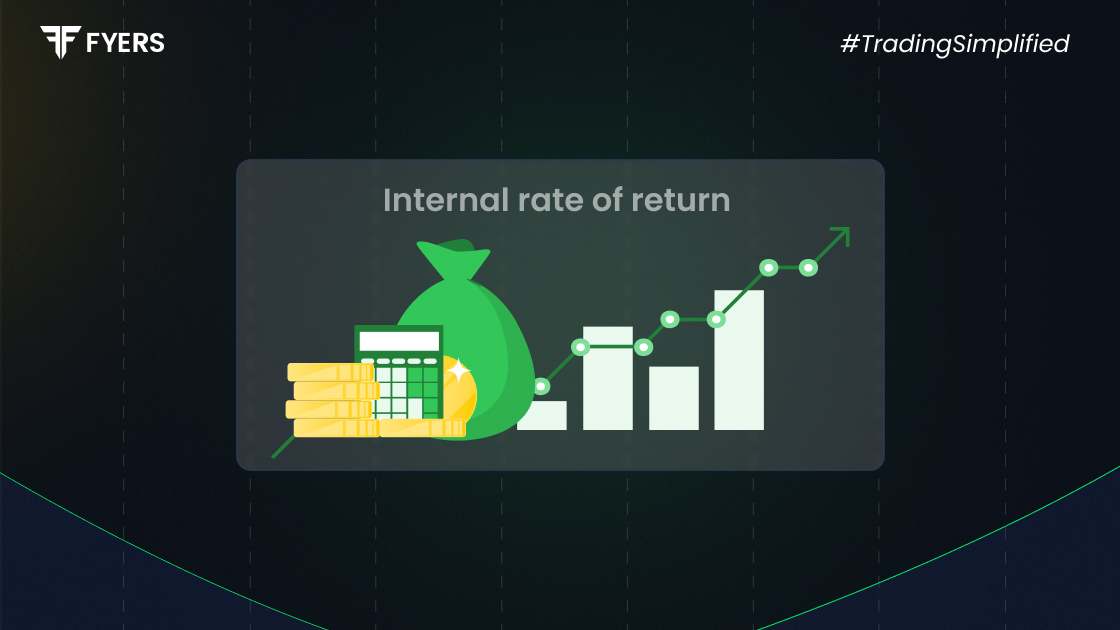

 16 Jul, 2025
16 Jul, 2025
 4 mins read
4 mins read

When you're evaluating investment opportunities - whether in mutual funds, business ventures, or capital projects - it's crucial to understand your potential returns. One of the most popular metrics used to estimate profitability is the Internal Rate of Return, or IRR. This percentage-based measure gives you a clearer idea of how well your investment might perform over time.
In this guide, we’ll simplify what IRR means, explain the IRR formula, show how to calculate IRR, and provide real-life examples to help explain the internal rate of return.
IRR, short for Internal Rate of Return, is the rate at which the Net Present Value (NPV) of all cash inflows and outflows from an investment becomes zero.
IRR meaning in simple terms: IRR is the break-even annual return you need to earn on an investment so that your total profit equals your initial investment.
It’s a way of answering the question: "What’s the yearly return I’m effectively earning, considering all the money going in and out over time?"
Unlike interest rates or ROI, IRR doesn’t have a straightforward formula. Instead, it solves this equation:
| NPV = 0 = ∑ [ Ct / (1 + IRR)^t ] – C₀ |
Where:
Ct = Cash inflow during time period t
C₀ = Initial investment (a negative value, since it's money going out)
t = Time period
IRR = Internal Rate of Return
Because it’s a complex equation, IRR is generally calculated using software tools like Excel or financial calculators rather than solving it manually.
Here’s how to find the IRR step by step:
List all cash flows: Include the initial investment (as a negative amount) and all expected income or returns in the coming years.
Use Excel or Google Sheets:
Enter all cash flows in a column.
Apply the =IRR() formula.
Excel will automatically calculate the IRR for you.
Manual method (trial & error): Try different discount rates until the NPV becomes zero, but this can be time-consuming.
Suppose your cash flows are:
Year 0 (investment): ₹−1,00,000
Year 1: ₹30,000
Year 2: ₹40,000
Year 3: ₹50,000
In Excel, input the values and use:
=IRR(A1:A4)
The result will be approximately 18%, which is your internal rate of return.
The internal rate of return is a versatile tool in both personal and business finance. Here's when it can be most useful:
Project Evaluation: Companies use IRR to decide whether a project or investment is worth pursuing.
Comparing Investments: Investors use IRR to compare potential returns across mutual funds, business ventures, or other assets.
Capital Budgeting: IRR helps decide how to allocate funds across multiple investment options.
Private Equity and Venture Capital: IRR is often used to measure fund performance over time.
In all these cases, IRR helps estimate the annual return you can expect based on projected cash flows.
Let’s say you invest ₹1,00,000 in a small business that promises to return:
₹30,000 in Year 1
₹40,000 in Year 2
₹50,000 in Year 3
By applying the IRR formula in Excel, you calculate the IRR to be around 18%. That means, on average, your investment earns an internal rate of return of 18% per year over three years.
If a fixed deposit or savings account offers only 7–8%, this investment seems more attractive - provided you're comfortable with the risk involved.
While the internal rate of return is helpful, it has its drawbacks:
Multiple IRRs: If a project has irregular or alternating cash flows (some years are losses, others are gains), it may produce more than one IRR, which can be confusing.
Ignores Project Size: IRR focuses only on the return percentage, not the total value. A smaller project with a higher IRR may bring less profit than a larger one with a lower IRR.
Unrealistic Reinvestment Assumption: IRR assumes that interim profits are reinvested at the same rate, which may not reflect reality.
Not Best for Mutually Exclusive Projects: When comparing projects with different durations or cash flows, using Net Present Value (NPV) might give a more accurate picture than IRR.
The Internal Rate of Return (IRR) is a widely-used metric that helps investors and businesses evaluate investment profitability. It represents the annualised return where the investment just breaks even - where the present value of all inflows equals outflows.
Although IRR is powerful, it should not be your only decision-making tool. Combine it with other financial indicators like NPV, ROCE and payback period for a more complete investment analysis.
IRR is the rate of return that makes your investment’s total profit equal to its cost - your break-even annual return.
IRR stands for Internal Rate of Return.
Yes. If the total cash inflows from the investment are less than the initial cost, the IRR will be negative - indicating a loss.
Calculate your Net P&L after deducting all the charges like Tax, Brokerage, etc.
Find your required margin.
Calculate the average price you paid for a stock and determine your total cost.
Estimate your investment growth. Calculate potential returns on one-time investments.
Forecast your investment returns. Understand potential growth with regular contributions.